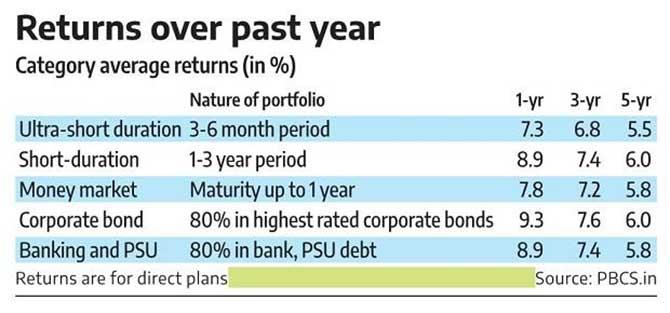‘Maintain a balanced approach with a preference for short-to medium-duration funds.’

Illustration: Uttam Ghosh/Rediff
Investors are increasingly favouring accrual-oriented debt funds like money market and short-duration funds over interest rate-sensitive categories, according to data from the Association of Mutual Funds in India (Amfi).
In June 2025, long-duration (Rs 445.9 crore), medium-to-long duration (Rs 65.8 crore), medium-duration (Rs 61 crore), gilt (Rs 957.3 crore), and gilt with 10-year constant duration (Rs 141.8 crore) funds recorded net outflows.
In contrast, short-duration funds and money market funds (MMFs) attracted strong inflows of Rs 10,276 crore and Rs 9,484 crore, respectively.
“Duration funds have seen net outflows as there is limited room for yields on the longer end to move lower from here. MMFs, on the other hand, have seen inflows on the back of surplus liquidity in the system,” says Jalpan Shah, head of fixed income, TRUST Mutual Fund.
“Given that RBI rate cuts and the consequent rally in bonds is almost over, it makes sense for investors to prefer MMFs and short duration funds over interest rate-sensitive bond funds,” says Joydeep Sen, corporate trainer (debt) and author.
Rate cycle paused
Following a 100-basis point policy rate cut since February 2025, market experts believe further easing is unlikely.
“The rate cycle has entered a pause phase following the significant easing seen over the past year. The 10-year G-Sec yield, currently around 6.32 per cent, is expected to trade in the 6.20-6.40 per cent range over the next 6 to 12 months,” says Devang Shah, head – fixed income, Axis Mutual Fund.
“We do not anticipate further repo rate cuts in the near term,” Devang Shah added.
“We expect the Monetary Policy Committee to keep the repo rate on hold at 5.50 per cent and liquidity in surplus over the next 3 to 6 months, with the 10-year G-Sec likely to trade in a range of 6.20 to 6.40 per cent,” says Jalpan Shah.
Accrual strategies in favour
Against this backdrop, investors seem to be switching from long-term to short-term bond funds.
“Accrual-oriented funds, such as money market, ultra-short, and short-duration funds, offer attractive yields with low volatility. They are well-positioned to benefit from the prevailing surplus liquidity and stable macro backdrop,” says Devang Shah.
Short-term bonds typically have lower interest rate sensitivity than long-term ones.
“Risk-adjusted returns through accruals are higher than capital gains in longer-dated G-Secs in the absence of any major triggers,” says Jalpan Shah.
Align fund duration with holding period
Experts advise aligning investment horizons with scheme duration.
“Match the investment horizon with the portfolio maturity of the fund and do laddering.
“Corporate bond funds are suitable for a three-year horizon.
“Target maturity funds are a good option for laddering.
“Debt-plus-arbitrage fund-of-funds (FoFs) are gaining popularity for their tax efficiency,” says Sen.

Blend categories prudently
A diversified approach is recommended.
“Maintain a balanced approach with a preference for short-to medium-duration funds.
“MMFs, ultra-short, and short-duration funds are well-placed to capture stable accrual income while minimising mark-to-market volatility,” says Devang Shah.
“Investors with a longer investment horizon and higher risk appetite may also consider a mix of 8-10-year G-Secs and short to medium corporate bonds, but with the understanding that the bulk of the rally has already occurred,” adds Devang Shah.
“Accrual strategy through investments in high-quality funds should be the preferred investor choice in the current environment.
“Categories like short-duration funds, corporate bond funds, and banking and PSU funds offer the accrual strategy,” says Jalpan Shah.
Disclaimer: This article is meant for information purposes only. This article and information do not constitute a distribution, an endorsement, an investment advice, an offer to buy or sell or the solicitation of an offer to buy or sell any securities/schemes or any other financial products/investment products mentioned in this article to influence the opinion or behaviour of the investors/recipients.
Any use of the information/any investment and investment related decisions of the investors/recipients are at their sole discretion and risk. Any advice herein is made on a general basis and does not take into account the specific investment objectives of the specific person or group of persons. Opinions expressed herein are subject to change without notice.
Feature Presentation: Ashish Narsale/Rediff





